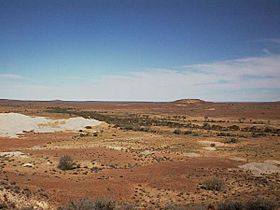Lake Torrens facts for kids
Quick facts for kids Lake Torrens |
|
|---|---|

Stuart Creek with Lake Torrens in the background
|
|
| Location | South Australia |
| Coordinates | 31°02′40″S 137°51′35″E / 31.04444°S 137.85972°E |
| Type | Salt lake |
| Primary outflows | Pirie–Torrens corridor |
| Basin countries | Australia |
| Designation | Lake Torrens National Park |
| Max. length | 250 km (160 mi) |
| Max. width | 30 km (19 mi) |
| Surface area | 5,745 km2 (2,218 sq mi) |
| Max. depth | 1 m (3.3 ft) |
| Surface elevation | 30 m (98 ft) |
Lake Torrens is a huge salt lake in the middle of South Australia. It's usually dry, but after a lot of rain, it can fill up with water. When it's really full, the water can even flow out to the Spencer Gulf through a path called the Pirie-Torrens corridor.
This amazing lake has islands! Two important ones are Andamooka Island and Murdie Island. They are both close to the western side of the lake. You can also find Trimmer Inlet and Carrapateena Arm here, which are like small water channels or arms of the lake.
Contents
About Lake Torrens
Lake Torrens is located between the Arcoona Plateau and the Flinders Ranges. It's about 65 kilometres (40 mi) north of Port Augusta. The lake sits about 30 metres (98 ft) above sea level. Even when it's full, its deepest point is only about 1 meter.
This massive lake is about 250 kilometres (155 mi) long. It is also about 30 kilometres (19 mi) wide on average. When it fills with water, Lake Torrens becomes Australia's second largest lake. It covers an area of 5,745 square kilometres (2,218 sq mi).
The lake is part of the Lake Torrens National Park. This park helps protect the lake and its surroundings.
Islands and Wildlife
Andamooka Island is the biggest island in Lake Torrens. It's a place where animals graze, but it's also very important for birds. Birds like the red-capped plover and cinnamon quail-thrush live here. Other islands are home to banded stilts.
Murdie Island is just south of Andamooka Island. Its name comes from the Barngarla or Kuyani languages. These names show the very first known connections to Lake Torrens. Other features include Carrapateena Inlet and Trimmer Inlet.
History of Lake Torrens
About 35,000 years ago, the water in Lake Torrens was fresh or slightly salty. Over time, it has become much saltier.
The traditional owners of the Lake Torrens area are the Arabunna people to the north. The Kokatha people are to the west, and the Kuyani people are to the east. The lake is also a sacred site for at least four groups: the Barngarla, Kokatha, Kuyani, and Adnyamathanha peoples.
The first European person to see the lake was Edward John Eyre in 1839. He saw the salt bed from Mount Arden. Eyre named the lake after Colonel Robert Torrens. He was one of the people who helped start the colony of South Australia. However, the Kuyani people had already called the lake Ngarndamukia. This name means "shower of rain."
The lake filled with water in 1897 and again in April 1989. When it filled in 1989, water flowed out to the Spencer Gulf. This suggests it likely did the same in 1897. The lake has a thin layer of salt on top. Underneath, there are soft, muddy, red-brown clays. The land around the lake has few plants. You can find samphire, saltbush, and bluebush.
In April 2013, the entire area of Lake Torrens was officially named a locality. This was done by the Government of South Australia.
Protecting Lake Torrens
South Australian Government Protection
The whole area of Lake Torrens has been a national park since 1991. It is protected under the National Parks and Wildlife Act 1972. This law helps keep the lake and its environment safe.
Other Protection Efforts
Lake Torrens is part of an area called the Inland Saline Lakes. This area has been listed in the Directory of Important Wetlands in Australia since 1995. This listing shows how important these wetlands are.
BirdLife International has also named Lake Torrens an Important Bird Area (IBA). It's called the Lake Torrens Important Bird Area. This is because it supported up to 100,000 breeding banded stilts when it filled in 1989. It can also sometimes support over 1% of the world's red-capped plovers. Cinnamon quail-thrushes are also common in this important bird area.
Exploring for Minerals
Companies sometimes want to explore for minerals under Lake Torrens. In 2017, a company called Kelaray got permission to drill for iron, copper, and gold. They planned to work with the traditional owners to protect important sites.
Some drilling was done in 2019. However, it was paused to review the underground water sources. In 2020, local Kuyani and Kokatha people shared their worries about more drilling plans.
In 2021, the state government allowed Kelaray to drill on the lake. This included areas like Murdie Island and parts of Andamooka Island. The company said they would use special mats to protect the lake's salt crust from vehicles. They also planned to talk regularly with Aboriginal representatives. However, some local people, like Regina McKenzie, were concerned that they were not fully consulted. The work is meant to find minerals similar to those found at the Olympic Dam mine and Carrapateena mine. This project is known as the Murdie project.
See also
 In Spanish: Lago Torrens para niños
In Spanish: Lago Torrens para niños


